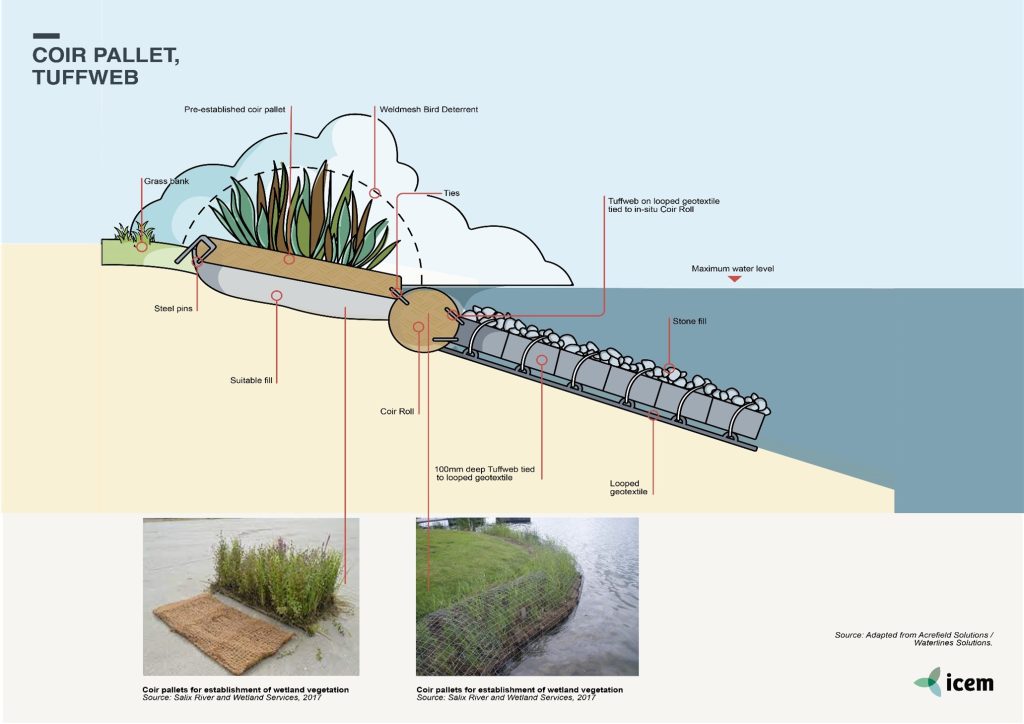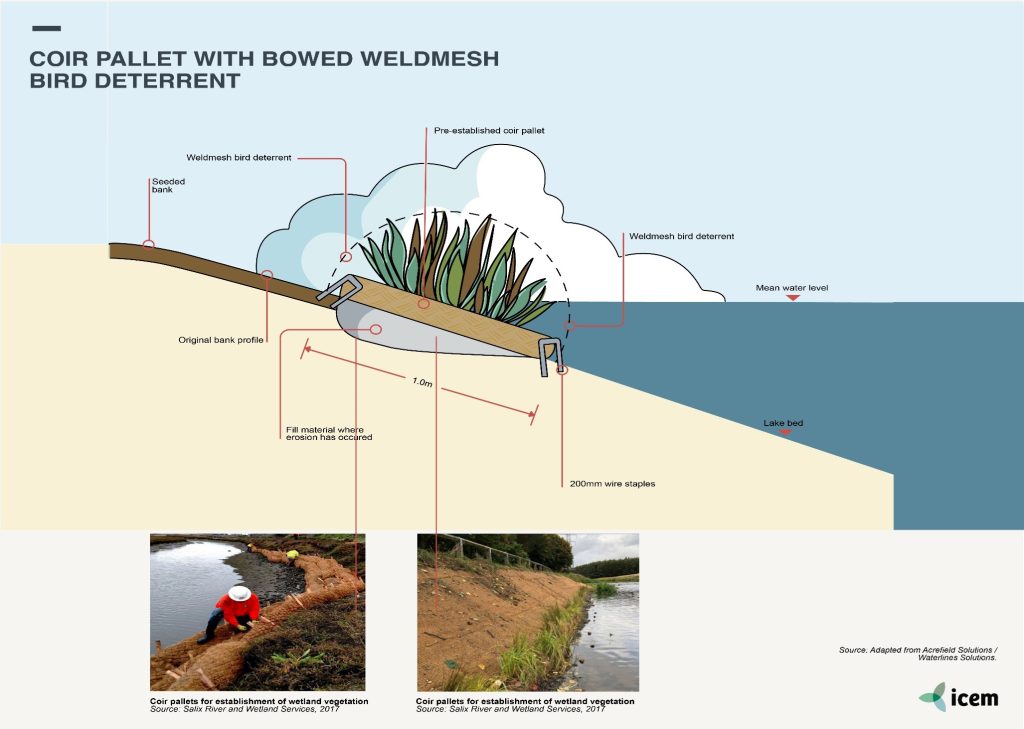| Suburban | River | Medium-cost | Riverbank erosion | |
| DESCRIPTION | |
| Measures
|
Coconut fibre, usually called coir, is used to make a wide variety of products which are biodegradable and are very useful for combating surface erosion and providing toe support to river banks. Coir rolls, mats and pallets are made from compressed coconut fibres and can be manufactured in various sizes and thicknesses. Coir absorbs and stores moisture, which is then released to the plants in dry periods. It also conserves moisture in the soil and provides insulation. As the roots mature creating an effective binding matrix the coir fibre progressively degrades, leaving a vegetation framework for a full wetland community to develop. Coir rolls are long cylinders usually placed at the base of slopes. Coir mats are used to promote re-vegetation in areas of disturbed ground. They protect against loss of soil and stabilize the riverbank while allowing vegetation to grow through. Coir pallets are thicker than coir mats and provide a stable growth substrate for plants in marginal growing conditions – encouraging root systems to establish and plant colonies to develop. |
| Location
|
Coir rolls are generally used at the bank toe to protect the toe from wave action and erosion from the stream shear forces. The coir mats are suitable for the stabilization of stream and river banks, road embankments and wetland construction. Coir pallets are a useful way to quickly establish marginal vegetation around the edges of streams and river banks. |
| Design options and performance
|
Coir products are designed for a range of erosion control and bank stabilization applications:
● Coir rolls dissipate wave energy, protect against water scour and retain the bank while plants develop. ● Coir mats are designed to protect banks against erosion and facilitate the establishment of vegetation on disturbed ground. They are used where the bank has a high potential for erosion due to heavy rainfall or on river banks and where re-vegetation requires added protection to establish. They are not suitable for very sandy soils or at sites subject to high-velocity flows or wave action since soil can be lost through the holes. ● Coir pallets help to establish native marginal vegetation around lake edges, streams, riverbanks, and ponds, and are beneficial on projects where no suitable soil medium exists e.g., gabion faces and floating islands. The coir fibres retain water, helping to keep plant roots moist, even in dry weather conditions. |
| Feasibility criteria
|
● Technical design: Coir mats are usually supplied in rolls of 2 m wide by 20 to 25 m long. Coir pallets come in a range of sizes and thicknesses but 2 m by 1 m is a common size. Mats need to be overlapped and anchored using pins or staples at 30 to 50 cm spacing depending on the firmness of the soil layer. It is important to ensure that the plants establish through the matting since if they do not then relaying and replanting will likely be required. Coir pallets are usually pre-planted with local vegetation.
● Soil media: n/a ● Soil slope: Up to 45° ● Surface cover: n/a ● Materials: compressed coconut fibres and in the case of coir pallets the fibres are contained in a coir or twine mesh. |
| Operation and maintenance | Coir products degrade over 3 to 5 years while the plants take over and their root systems support the river bank. The only maintenance needed is when sections of the coir become damaged (during floods) and will need replacement. |
| Cost and benefits | Medium cost. Coir mats and pallets provide a biodegradable alternative to hard revetments to stabilize embankments and are a natural solution for establishing native marginal vegetation around edges of streams, river banks, lakes and ponds. By providing habitat they increase the biodiversity of a site. |
| Design solutions | Design solutions:
● Coir rolls prevent undermining at the toe of the stream bank and are flexible which allows them to be adjusted to bank contours with limited disturbance to the stream flow. Plants can also grow in the roll, which makes the measure more effective for erosion control. ● Coir mats check shallow earth slips. ● Sediments are easily trapped by the coconut fibre. ● Manufacturers claim that coir products remain effective for controlling stream bank erosion for a period of 6 to 10 years. Care must be taken that rolls are not dislodged by high water levels before vegetation becomes established since wave action may cause the stake anchors to loosen. |
| Environmental performance | Coir products can be used for environmentally friendly and aesthetically pleasing applications in erosion and sediment control:
● Provide stable areas for the establishment of other vegetation such as trees and shrubs; ● Provide immediate slope stabilisation and helps to store sediment; ● In addition to reducing wave energy, coir products can help contain substrate and encourage the development of wetland communities; ● Coir products decompose overall several years but the rolls allow the vegetation to become well-established and the root system takes over the bank stabilization role. For rolls and pallets, this effect is enhanced if the rolls are originally planted with suitable plant species. |
| Source | ● Salix River & Wetland Services Limited (https://www.salixrw.com/product/coir-rolls)
● Hy-Tex UK Ltd. Brochure (www.hy-tex.co.uk) ● United States Department of Agriculture – Natural Resources Conservation Service, 1996. Engineering Field Handbook, Chapter 16: Streambank and Shoreline Protection. |
Originally developed under the ADB ‘TA-9417 VIE: Secondary Green Cities Development Project – Output 2: Demonstrated sustainable and resilient development in Hue, Ha Giang and Vinh Yen’. Adapted for the UN-CTCN project ‘Climate risk assessment for subnational adaptation and establishment of a local climate information system for climate change adaptation (LISA) in Cambodia’.




